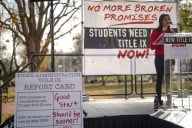You have /5 articles left.
Sign up for a free account or log in.
The open-door admissions policies of community colleges and the national college completion “agenda” are contributing to an influx of unprepared students who have little chance of earning a degree, and who are likely to rack up crippling debt along the way.
That’s the central argument of a newly released book, Community Colleges and the Access Effect: Why Open Admissions Suppresses Achievement (Palgrave Macmillan). To help fix this problem, the book’s co-authors, Juliet Lilledahl Scherer, a professor of English at St. Louis Community College, and Mirra Leigh Anson, director of TRIO Upward Bound at the University of Iowa, propose raising the minimum requirements for college entry.
Both Scherer and Anson have taught at the community college level. And their book describes students they have seen fail, with heartbreaking consequences.
For example, one of the authors currently mentors a former community college student who was shot in the head when he was 16. Despite lingering cognitive and physical problems, the impoverished student made the “hope-filled, but ill-advised” decision to enroll in college.
The student got a transcript of Fs and dropped courses to show for his community college experience. He also carries debt, which made him ineligible for a work force training program. It will be difficult to pay down with his part-time job, which pays $7.35 an hour.
Scherer and Anson responded to questions about their book via email.
Q. Your book argues that open-door admissions at community colleges can be a "cruel hoax" that perpetuates inequity. How so?
A. Due to a dramatic shift in the preparation and ability levels of entering community college students, open access to the financial aid-eligible curriculum now extends false promise to many. Most community colleges addressed the arrival of students with lower and lower basic skill and/or ability levels over the past 50 years by designing and offering courses to meet their skill levels. Lengthy developmental education sequences resulted, with credit-bearing coursework now being offered at some community colleges that is equal to standard kindergarten fare. Unsurprisingly, research shows that adults entering with basic skill levels far below what are required to succeed in college-level courses infrequently persist and complete traditional two- or four-year college degrees. Open-access policy is also responsible for a great deal of secondary-student inertia, which compounds low college readiness and completion rates. Even so, as we search for ways to improve U.S. postsecondary outcomes, open access is almost never questioned as a policy that brings anything but opportunity and positivity to students’ lives.
In this modern era of college-going, however, open-door policy continues to accomplish positive outcomes for some while it simultaneously exacts devastating injuries on others. To make matters worse, the students most often hurt when they enroll in programs beyond their completion abilities belong to America’s most socioeconomically disadvantaged groups. Students’ lives are at stake, and they -- along with the rest of America -- are looking to community colleges for leadership and answers. It is past time to engage in a more honest national conversation about the irrefutable link between sufficient academic preparation and postsecondary completion and then commit to policies and practices that achieve both for more Americans.
Q. How has the national college completion agenda contributed to these problems?
A. The national college completion agenda movement threatens postsecondary student success in several ways. Some of the more important ways include being so fixated on improving completion rates that academic standards are threatened and alternative postsecondary pathways that would better serve some students and their unique abilities, interests and goals are not as seriously considered as they should be. Second, many completion agenda advocates are ascribing far too much weight to length of developmental education sequences as the reason so many community college students do not complete credentials while failing to sufficiently acknowledge the monumental impact of academic preparation, aptitude and student motivation on completion.
In short, because we are not asking all of the right questions, we are arriving at some incorrect conclusions, which has led to some devastating policy selection.
"Reasonable entrance standards, coupled with a more compassionate approach to advising and enrolling community college students, will accomplish more genuine postsecondary student success and equity gains than any other combined set of policies and, importantly, it will do so without enervating academic standards."
Third, some completion agenda-related foundations and their intermediaries have bought up many of the limited seats at state and federal policy making tables and are forcefully communicating their policy ideals through multimillion-dollar megaphones, even as they are not accountable to taxpayers for their actions. Meanwhile, the valuable voices of America’s professional educators are systematically drowned out.
The result? Many important decisions are not being made in the interest of students whose futures depend on a strong U.S. public education system that honors the value of lifelong learning over “getting through as soon as possible.”
Q. Haven't completion advocates also elevated the issue of student success, pushing community colleges to care more about what happens to students?
A. Without a doubt, completion advocates are responsible for increasing community college attention on student success, which has brought about positive institutional change. Make no mistake, though, community colleges could never be accused of being casual about student success. In fact, nowhere else in higher education have more student success conversations occurred, nor more effort expended to help postsecondary students achieve.
One of the community college’s greatest strengths -- its focus on excellent teaching -- has been revealed over the past few years to also be a vulnerability. Community colleges have never had the resources to conduct longitudinal, cross-institutional, rigorous research about their own students and institutions. As a result, community colleges are presently forced to defer to the research findings and recommendations made about them by university researchers and pretty much any outsider with a question and funding. One of the best outcomes that could result from the modern postsecondary student success movement would be investment by the community college sector in its own researchers. Researcher-practitioners of an institution will naturally ask different -- and arguably better -- questions. And the answers to those questions will provide a necessary counterbalance to agenda-driven research and ultimately move all stakeholders closer to adopting practices and policies that will genuinely improve postsecondary student success.
Q. You suggest that community colleges set a new admissions standard. How could that help preserve academic quality and a "culture of learning"?
A. Just a few weeks ago, one of our students reported being intrigued by content in Community Colleges and the Access Effect after hearing it described in class during a discussion on the strong link between student motivation/engagement and academic achievement. In an end-of-semester reflection paper, the student admitted, “I am that student who is not up to par for college.… I was the kid who never really tried in school, especially junior and senior year of high school, because I knew I was going to (the local community college) after high school.”
In our book, we also relay the shocking anecdote of a junior, tenure-track math faculty member who disclosed that her department chair had explicitly instructed her and her colleagues to lower standards to achieve the student success rates needed at the institution to maintain or increase the current budget under the new performance funding formula.
Open access and performance-based funding are on a collision course, and degradation of academic standards is the predictable consequence. Lowering academic standards, though, to achieve continuously improved completion rates and/or other student success outcomes prone to manipulation will only buy community colleges time and eventually be their and their students’ death knell in an increasingly competitive, outcomes-driven world. Therefore, demanding more of students before granting them access to financial aid-eligible college degree pathways represents a logical and benevolent element of any successful postsecondary completion solution.
Because of their geographic accessibility and affordability, community colleges have routinely -- and rightly -- been identified as the U.S. higher education institution most capable of and responsible for our country’s economic and employment rebound. We are asking educators and policy makers to dispassionately inventory the negative impact on postsecondary student success of maintaining laissez-faire open-door policy in the new century and also thoughtfully consider the myriad benefits that will result from requiring students to demonstrate a reasonable ability to benefit from the programs in which so many current enrollees are not remotely prepared to complete.
Reasonable entrance standards, coupled with a more compassionate approach to advising and enrolling community college students, will accomplish more genuine postsecondary student success and equity gains than any other combined set of policies and, importantly, it will do so without enervating academic standards.
Q. The book includes devastating stories about students who weren't prepared for college. What should we learn from their struggles?
A. Our postsecondary students’ stories serve to confirm the reality that citizens with the greatest challenges in life frequently arrive on the community college’s doorstep, and their unfortunate circumstances are often intensified when they are steered onto pathways that are an ill match for their preparation, ability and/or circumstances. America can no longer abide the approach of encouraging grossly unprepared students onto inadvisable postsecondary pathways, confusing unfettered access with legitimate opportunity.
Our most fragile citizens -- the ones to whom enrollment is granted with the most noble intent of helping them improve their lives -- are not infrequently left worse for their encounter with a community college. Improving postsecondary student outcomes in America will require community colleges to not only develop and offer a fuller complement of postsecondary education opportunities, but to also more assertively advise students about the unique array of postsecondary programs in which they could reasonably be expected to succeed. Any lesser approach in the current environment of college-going will perpetuate inequity and enhance socioeconomic stratification -- the opposite intent of the community college.
Q. What are some of the alternative educational paths that students could pursue outside of college?
A. Because socioeconomic mobility and other important quality-of-life outcomes are strongly linked with an individual’s level of postsecondary education, we must first redouble our efforts to prepare every capable U.S. secondary student for college success. However, meaningful postsecondary education options do exist and can even be expanded when we commit to more conscientiously addressing postsecondary students’ unique and varied needs. Some current degree-seeking students would thrive more -- completion-wise and financially -- in apprenticeships and job-training programs than they would in traditional two- or four-year degree programs.
Some are in desperate need of short-term training programs to financially stabilize them so that one day they might return and succeed in a more traditional degree program. Instead of repeatedly enrolling in and failing developmental education coursework aimed at eventually qualifying students for college-level coursework, many persons with intellectual disabilities, for example, are truly in need of affordable postsecondary programs to assist them in developing a career plan and independent living skills, including learning to manage their money and their personal safety and health, for example.
Every community college will ideally continue serving as the most important postsecondary education hub in its community, but more postsecondary programs need to be developed and offered to sufficiently meet community members’ diverse needs. More partnerships and bi-directional referrals need to be accomplished with existing community organizations. And, notably, reliable public funding must be dedicated to support the high-quality postsecondary education programs expected to be offered by the community college, a societal treasure that has the strong potential to be looked upon by historians as America’s most important postsecondary institution of the 21st century.








